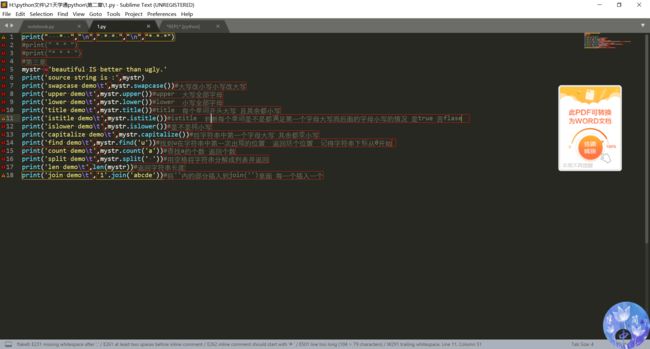print(" * ","\n"," * * ","\n","* * *")
#print(" * * ")
#print("* * * ")
#第三章
mystr ='beautiful IS better than ugly.'
print('source string is :',mystr)
print('swapcase demo\t',mystr.swapcase())#大写改小写小写改大写
print('upper demo\t',mystr.upper())#upper 大写全部字母
print('lower demo\t',mystr.lower())#lower 小写全部字母
print('title demo\t',mystr.title())#title 每个单词开头大写 且其余都小写
print('istitle demo\t',mystr.istitle())#istitle 判断每个单词是不是都满足第一个字母大写而后面的字母小写的情况 是true 否flase
print('islower demo\t',mystr.islower())#是不是纯小写
print('capitalize demo\t',mystr.capitalize())#将字符串中第一个字母大写 其余都变小写
print('find demo\t',mystr.find('u'))#找到u在字符串中第一次出现的位置 返回这个位置 记得字符串下标从0开始
print('count demo\t',mystr.count('a'))#查找a的个数 返回个数
print('split demo\t',mystr.split(' '))#用空格将字符串分解成列表并返回
print('len demo\t',len(mystr))#返回字符串长度
print('join demo\t','1'.join('abcde'))#将''内的部分插入到join('')里面 每间隔一个插入一个
python里面int(x,base=10)把x转化为十进制整型
str(一个数) 把一个数转化为字符串
特别注意float ()和int() 可以把数转化为字符串但是字符串必须加" " 或者' '牢记!
将字符串分解成列表 然后将列表的所有元素转化成int类型
用map()函数
map(int ,alst)
会根据提供的函数对指定序列做映射。
第一个参数 function 以参数序列中的每一个元素调用 function 函数,返回包含每次 function 函数返回值的新列表。
map() 函数语法:
map(function, iterable, ...)
例子:
mystr=input("请输入三个整数用空格隔开")
print('split demo\t',mystr.split(' '))#用空格将字符串分解成列表并返回
alst= mystr.split(' ')
alst_number=list(map(int, alst))#将alst里面的元素转换为int类型 #这个list不知道为毛要加 还没弄明白
print(alst_number)
print(min(alst_number))
